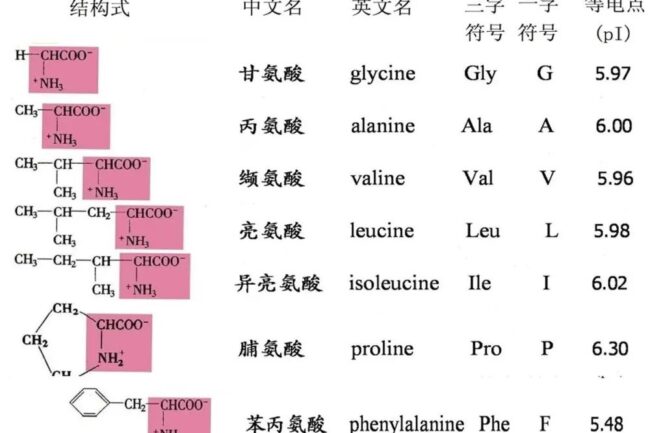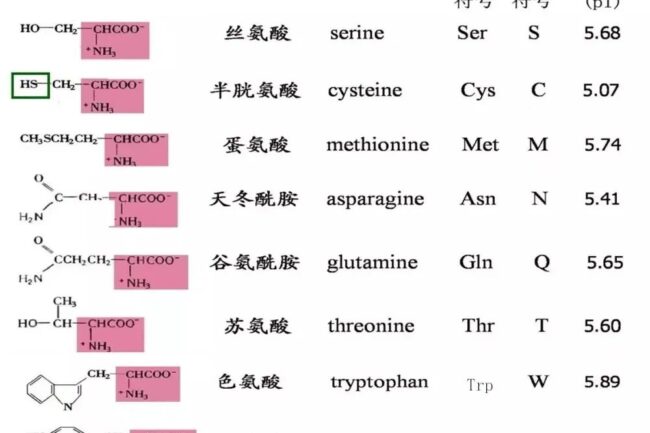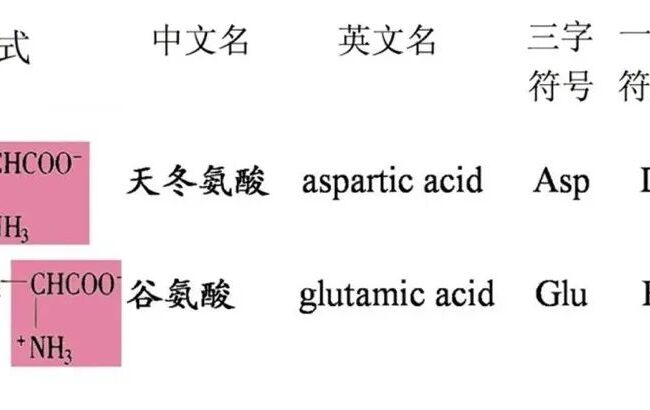Name is a technical work, everyone, every thing has a wonderful story behind the name. Amino acid name origin is also very interesting, this article collects 22 kinds of amino acid name origin, for you to understand the relevant history.
Non-polar aliphatic amino acids

Glycine (Gly) Glycine
In 1820, when H. Braconnot was studying the hydrolysis of gelatin, he isolated glycine, which was considered a sugar at the time, but it was later discovered that this “gelatin sugar” contained nitrogen atoms and was the simplest amino acid, called glycine (from the Greek word glykys, meaning “sweet”). glycine (from the Greek word glykys, meaning “sweet”, ‘glykys’, meaning “sweet”). In fact, glycine is 80% as sweet as sucrose. Glycine was the first amino acid discovered by man and is the simplest, non-polar, non-spinning amino acid. Glycine is extracted from soybeans.
Alanine (Ala) Alanine
According to the rules of organic nomenclature, Alanine is derived from acetaldehyde, ethanol, and ethyl from the Arabic article al-.
Valine (Val) Valine
Valine was isolated by Von Group Besanez in 1856 from an extract of the pancreas until 1906, when Fisher analyzed its chemical structure as 2-amino-3-methylbutyric acid and named it valine, from valerian.
Leucine (Leu) Leucine
Leucine (also known as leucine) was first isolated from cheese by Proust in 1819, and later crystallized from acid hydrolysate of muscle and wool by Braconnot (1820) and named Leucine. The English name Leucine is derived from the Greek word leuco, meaning ‘white’. It is called leucine because it is a white powder, and leucine because it crystallizes easily and has a high refractive index and is very shiny.
Isoleucine (Ile) Isoleucine
The name Isoleucine is derived from the Greek word isos, which is an isomer of leucine, and is derived from isomerism, which in turn is derived from the Chinese word iso.
Proline
First discovered by Fischer in 1901 in white gelatin. The English name is Pyrrolidone Carboxylic Acid (吡咯酮羧酸), and in order to simplify it, it became “Proline”. The Chinese name “Proline” is because it is an important component of collagen, of which “Pro” means dried meat, dried fruit.
Phenylalanine (Phe)
According to the rules of organic nomenclature. Phenyl is derived from the Greek word phaino (shiny). Alanine is derived from acetaldehyde, ethanol, and ethyl from the Arabic article al-.
Polar Neutral Amino Acids
Serine (Ser) Serine
Sericine was hydrolyzed in sulfuric acid by Cramer in 1865, and was initially mistaken for glycine. Later, it was found that its molecular structure was very similar to that of alanine, except for the presence of a hydroxyl group in its molecular structure. Since this nitrogen-based acid was isolated from sericine protein, it was named “Serine”.
Cysteine (Cys) Cystein
Cystein is half of Cystine, so it is called Cysteine in Chinese. Cystinol was so named because it was discovered by Wollaston in 1810 from a bladder stone (cystolith), and Berzelius named it cystine in 1832.
Methionine (Met) Methionine
Methionine is found in large quantities in eggs, hence the name “methionine”. Methyl is derived from the Greek word methy; thio is derived from the Greek word theion (sulfur).
Asparagine (Asn) Asparagine
Named after a derivative of Asparagine, first discovered in 1806 from the juice of asparagus, an herb of the Asparagus family.
Glutamine(Gln)
Named according to the derivative nomenclature, Gln was discovered by Schulze from beet juice in 1883, and later detected in germinated seeds and protein.
Threonine(Thr)
Threonine was isolated and identified by Mccoy et al. in 1935 from fibrin cleavage products, and its spatial structure was studied by Meyer in 1936, and it was named Threonine because of its structural similarity with threose.
Tryptophan (Trp) Tryptophan
Tryptophan was isolated by Frederick Hopkins and Syndey Cole in 1901 when they digested casein with insulin, and the name Tryptophane is derived from Trypsin (insulin), and phane, the Greek word for ‘appear’. (Strangely, this amino acid is not ending with ‘ine’, like most other amino acids, but ending with ‘ane ‘.)
Tyrosine
First discovered in cheese by a German chemist (“Tyro” means cheese in Greek), hence the name Tyrosine.
Acid Amino Acid

Asparagus (Asp) Asparatic acid
Asparagine (Asn) was isolated from the sap of asparagus by L.N. Vanquelin and J.P. Robiquet in 1806, and from an isolate of the roots of hollyhock (Althaenrosea) by A. Plisson in 1827. Ritthausen isolated aspartic acid from protein in 1868. It is called aspartic acid because it was first found in asparagus.
Glutamic acid (Glu)
Glutamic acid, a component of monosodium glutamate (MSG), was first extracted from wheat gluten by a German professor in 1861. Later, in 1908, Kikumo Ikeda of Japan broke down MSG from the juice of boiled seaweed and introduced it to the market for the first time as an artificial seasoning. It was called glutamic acid because it was mainly extracted from glutelin.
Alkaline Amino Acids

Arginine
Arginine was first isolated from lupine seedlings by Schlus in 1886, and in 1895 Hedin discovered that it was present in mammalian proteins. In 1895, Hedin discovered that arginine was present in mammalian proteins. The natural product is found in large quantities in fish protein (protamine), hence the name arginine.
Histidine (His)
Histone has a high content in proteins, so it is called histidine. Histidine was first isolated in 1896 by the German physician Albrecht Kossel.
Lysine (Lys) Lysine
Lysine was isolated by Dreehsel in 1889 from hydrolyzed casein. At that time, what was actually obtained was a mixture of lysine and arginine, named Lytatine. Later, Fisher isolated lysine from this Lytatine and named it Lysine.
Selenium cysteine(Sec)
Following the nomenclature, Selenium(Selenium)+cysteine(Cysteine); the structure is similar to cysteine, only the sulfur atom is replaced by selenium.In 1978, Forstrom and Tappel identified the active center of glutathione peroxidase as Selenium Cysteine(Sec), which is the 21st amino acid known to be involved in the biosynthesis of proteins. Amino acids.
Pyrrolysine (Pyl) Pyrrolysine follows the nomenclature.
Pyrro (pyrrole) + lysine (lysine); discovered in 2002 by two research groups from The Ohio State University from the enzyme methylaminomethyltransferase of a methanogenic bacterium; the 22nd amino acid known to be involved in protein biosynthesis. However, it is not a protein amino acid that makes up the human body.
